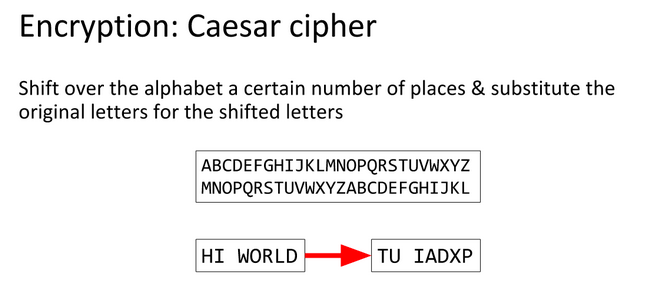

Provenzano's cipher used numbers, so that "A" would be written as "4", "B" as "5", and so on. In April 2006, fugitive Mafia boss Bernardo Provenzano was captured in Sicily partly because some of his messages, written in a variation of the Caesar cipher, were broken. Keywords shorter than the message (e.g., "Complete Victory" used by the Confederacy during the American Civil War), introduce a cyclic pattern that might be detected with a statistically advanced version of frequency analysis.


The conditions are so difficult they are, in practical effect, never achieved. If the keyword is as long as the message, chosen random, never becomes known to anyone else, and is never reused, this is the one-time pad cipher, proven unbreakable. The Vigenère cipher uses a Caesar cipher with a different shift at each position in the text the value of the shift is defined using a repeating keyword. A Caesar shift of thirteen is also performed in the ROT13 algorithm, a simple method of obfuscating text widely found on Usenet and used to obscure text (such as joke punchlines and story spoilers), but not seriously used as a method of encryption. Even as late as 1915, the Caesar cipher was in use: the Russian army employed it as a replacement for more complicated ciphers which had proved to be too difficult for their troops to master German and Austrian cryptanalysts had little difficulty in decrypting their messages.Ĭaesar ciphers can be found today in children's toys such as secret decoder rings. Kahn (1967) describes instances of lovers engaging in secret communications enciphered using the Caesar cipher in The Times. In the 19th century, the personal advertisements section in newspapers would sometimes be used to exchange messages encrypted using simple cipher schemes. The letters of the cryptogram themselves comprise a religiously significant "divine name" which Orthodox belief holds keeps the forces of evil in check. This may be a holdover from an earlier time when Jewish people were not allowed to have Mezuzahs.

The earliest surviving records date to the 9th century works of Al-Kindi in the Arab world with the discovery of frequency analysis.Ī Caesar cipher with a shift of one is used on the back of the Mezuzah to encrypt the names of God. There is no record at that time of any techniques for the solution of simple substitution ciphers. It is unknown how effective the Caesar cipher was at the time, but it is likely to have been reasonably secure, not least because most of Caesar's enemies would have been illiterate and others would have assumed that the messages were written in an unknown foreign language. There is even a rather ingeniously written treatise by the grammarian Probus concerning the secret meaning of letters in the composition of Caesar's epistles. There is evidence that Julius Caesar used more complicated systems as well, and one writer, Aulus Gellius, refers to a (now lost) treatise on his ciphers: Whenever he wrote in cipher, he wrote B for A, C for B, and the rest of the letters on the same principle, using AA for X. His nephew, Augustus, also used the cipher, but with a right shift of one, and it did not wrap around to the beginning of the alphabet: If anyone wishes to decipher these, and get at their meaning, he must substitute the fourth letter of the alphabet, namely D, for A, and so with the others. If he had anything confidential to say, he wrote it in cipher, that is, by so changing the order of the letters of the alphabet, that not a word could be made out. While Caesar's was the first recorded use of this scheme, other substitution ciphers are known to have been used earlier. The Caesar cipher is named after Julius Caesar, who, according to Suetonius, used it with a shift of three to protect messages of military significance.


 0 kommentar(er)
0 kommentar(er)
